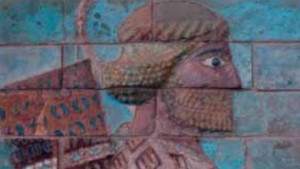In 1978 the publishders Lund Humphries published a book with the lengthy title "The Bisitun inscriptions of Darius the Great Babylonian Version", by Elizabeth Von Voightlander. This academic volume was never likely to be a best seller, but it did render a vital service to the archaeological world, and is still being offered for sale.
High on the rock-face of the western end of the Zagros Mountains Darius the Great of Persia left an inscription in three languages, written in the cuneiform script, which proved to be the key that unlocked the mysterious cuneiform script. This enabled scholars to read the many tablets and reliefs that revealed the history of the great empires of the past.
In 1836 Sir Henry Rawlinson was the first scholar to record the existence of this inscription, and it was he who grappled with the text, and was finally able to translate and read the contents of the inscription. In the process he was able to pass on to future generations a price- less key to all the cuneiform texts that have been discovered.
Rawlinson was born in Oxfordshire in 181 0, and at the age of 17 went to India as a cadet under the East India company. After 6 years as a subaltern he was sent to Persia with some other English officers to reorganize the Shah's army
The Bitsun Inscription
Rawlinson became deeply inter- ested in ancient Oriental lang- uages and soon became a pro- ficient translator. He took a particular interest in the inscription on the rock-face at Bisitun, some- times called Behistun, the little village on the road between Baghdad and Hamadan. He decided to make paper mache squeezes of the inscription so that he could study it at leisure.
ld study it at leisure. ' The rock-face had been smoothed by the original engravers, and a shelf made at the foot of the relief. Below the shelf the rock had been smoothed almost vertically down to the valley below, so to copy the text Rawlinson had to be suspended by ropes from the mountain top above, and swinging in mid-air, copy the areas that were not reachable from the shelf.
But before he could complete his task, friction developed between the two governments and the British officers were obliged to leave. In 1840 Rawlinson became political agent at Kandahar in Afghanistan, and subsequently requested a transfer to Baghdad. Here he devoted much of his time to studying the cuneiform text, and was able to complete his transcript of the Bisitun text.
While in Persia, Rawlinson had found two short inscriptions which he correctly identified as being in three different languages, Old Persian, Elamite and Babylonian. In these texts he had noticed the repetition of three words which he concluded were the names of three successive kings which he guessed were Hystaspes, Darius and Xerxes in their Old Elamite form. This gave him 14 characters out of the Persian alphabet of 43 characters, and by 1847 he was able to read the whole of the Persian inscription.
But the Babylonian script was not alphabetical, and was much more complicated with many more characters than the Persian.
However, with the realization that Babylonian was closely akin to Hebrew, Rawlinson was finally able to announce to the scholastic world that the cuneiform could now be read. Layard was by now exca- vating at Calah and Nineveh, and together they were able to translate some of the cuneiform texts that Layard had discovered.
A Reluctant Admission
But instead of hailing with joy the decipherment of the script the academic world received the announcement with a critical dis- belief, and it was not till 10 years later in 1857 that the scholars grudgingly admitted that the script could indeed be read and then it was only as the result of a challenging test.
The Royal Asiatic Society sent out the text of a recently dis- covered clay cylinder to four scholars who claimed to be able to read the cuneiform - Rawlinson, Talbot, Hincks and Oppert, with instructions to return their trans- lations under seal to the society. The four scholars complied and when the translations were opened and compared at a meeting of the society, they were found to be in complete agreement. The president of the society announced that there could henceforth be no further doubt that the script could be read.
About two thirds of Rawlinson's squeezes have been preserved in the British Museum, but later scholars wanted a copy of the full text to study, and a latex copy would naturally be more accurate than Rawlinson's rather primitive squeezes. So, in 1948 Dr George Cameron, using a painter's scaffold, made latex copies of the inscriptions. Unfortunately, the latex was not properly stored and most of them were damaged beyond recognition. Undaunted, Cameron returned to Bisitun and in 1957, this time swinging from an improvised boatswain's chair, made another set of impressions.
Enter Elizabeth Voightlander
In 1966 Elizabeth Voightlander's husband was transferred to Tehran where he served for seven years as an engineering consultant to the Ministry of Power. During this time Elizabeth was able to give intensive study to the Bisitun inscriptions. Her observations and conclusions form the substance of her book.
The central feature of the monument is a relief about 3 m high
and 5.5 m wide. It depicts Darius I Hystaspes, or Darius the Great, who was King of Persia 522-486 BC. Soon after he came to the throne he revoked the prohibition of his predecessor, and allowed the Jews to resume work on the rebuilding of their temple in Jerusalem. Ezra 5.
He built the magnificent city of Persepolis in south-west Iran, as well as a palace in Shushan. He led a disastrous invasion of Greece which ended in defeat at Marathon in 490 BC.
On his relief at Bisitun Darius is depicted with his foot on the neck of his deposed enemy Gaumata. Behind him are two officials, and in front of him are eight rebel chiefs with their hands bound behind their backs, and ropes around their necks. Above them is the Persian symbol of the deity Ahura Mazda.
On the right of the relief is an Elamite text, and on the left is the Babylonian text, while below the relief is the Old Persian version. Apparently the first Elamite text was mutilated when the relief was extended to the right and the ninth figure added, so a second Elamite version, an exact copy of the first, was inscribed beneath the Babylonian text.
Darius the Great had it written
The monument was made in the first year of Darius, but Darius did not conquer the rebel Skunkha until his third year. He apparently then ordered Skunkha to be added to the list of rebels, and so the ninth figure was added, necessitating the writing of the second Elamite text.
The rebels are each identified by a brief inscription in Elamite above each head, and a Babylonian version beneath each figure, but the Persian texts are in disorderly locations, suggesting that they were added as an afterthought.
The texts have been very carefully engraved with few scribal errors. Where scribes checked the text and found a mistake the error has been partially erased by smoothing it down and then inscribing the correct character.
Strange to say, although Darius was a Persian, the original text seems to have been the Babylonian. The Elamite text does not contain all the information of the Babylonian, and apparently is a briefer translation of the Babylonian. The Old Persian text seems to follow a different pattern to the other two, and so may be a loose translation of the original text, rather than being the original.
Apparently Darius himself dictated what was to be written in the inscription, because he starts off by saying, "I am Darius the King, son of Hystaspes," and thereafter each paragraph commences with the formula, "King Darius states . . ."
The text of the inscriptions falls into eight sections, in each of which . Darius ascribes all praise to the deity Ahura Mazda.
First, Darius relates his family history and establishes his own identity and right to the throne by reason of his descent from Achaemenes. Then he enumerates the lands that obeyed his laws and paid tribute to Persia
Third is the story of his accession to the throne. Cambyses was the son of Cyrus the Great, and reigned from 530 to 522 BC. In 525 he marched his army into Egypt. The inscription relates that before leaving for Egypt Cambyses had his brother Bardiya killed though the
Persian populace was not aware of this. Bardiya, known to the Greeks as Smerdis, was apparently popular with the people and Cambyses wanted to make sure that he did not usurp the throne during his absence.
The False Smerdis
But this preventive measure backfired. Darius recorded that "Gaumata the Magian . . . lied to the people saying, I am Bardiya the son of Cyrus . . . Then all the troops revolted from Cambyses and went over to him." Darius claims that Cambyses died of a self inflicted wound, and that Gaumata pro- ceeded to kill anyone who might betray the fact that he was not the true Bardiya. Gaumata is known in most history books as the False Smerdis.
It was probably this process of elimination which aroused the fears of Darius. He may have been the next on the hit-list, so he killed Gaumata.
In section 4 Darius' relates how he restored prosperity to Persia, and section 5 constitutes the major content of the inscrip- tion, in which he tells how he defeated the kings who rebelled against him. Atrina led the Elamites against Darius but was defeated and executed. Nidintu-Be1 claimed to be a re-incarnated Nebuchad- nezzar and led the Babylonians in a rebellion. Darius defeated his army. "We killed all of them and took no prisoners." Darius then occupied Babylon and "Impaled Nidintu-Bel and the nobles who were with him."
Then another usurper, Martiya, arose in Elam claiming to be Immaneshu, king of Elam. Darius marched on the Elamites who took fright and slew Martiya
Then in Media another usurper, Fravartish, appeared claiming to be Khashatritti, a descendant of Cyaxeres. Darius sent his troops who fought a series of successful battles with the Medes.
Finally Darius himself left Babylon with an army which defeated the Medes, killing 34,425 of them and taking many prisoners. Khashatritti himself was captured, and Darius "Cut off his nose, his two ears, his tongue, and blinded one of his eyes." He was then displayed in fetters at the gate for all to see. Finally, he was put out of his misery by being impaled. Shitran- takhma, a Sagartian, suffered a similar fate when he rebelled.
Yet another Persian usurper, Vahyazdata by name, tried to impersonate the dead Bardiya. Darius sent his troops against him and the rebels were defeated. Vahyazdata and his nobles were all impaled.
Finally the Babylonians staged another rebellion, and Arakhu of Ur also claimed to be the long-dead Nebuchadnezzar. He and his nobles were also impaled.
Well, it was certainly the year of the impersonation game. So much so that in section 6 Darius goes on to do some moralising. "Protect yourself well from lies," he warns, "Do not trust the man who lies. Vigorously prosecute him."
Finally, in section 7 admon- ishes all who follow him to protect his monument and utters a curse against any who would dare to deface it. "May Ahura Mazda curse you, and may you have no descendants, and may Ahura Mazda grab from your hands whatever you may acquire."
Section 8 concludes with a tribute of praise for the men he names as his supporters.
The Herodotus Account
Herodotus, the Greek traveller and historian who wrote soon after all this happened, supplies some interesting details of the drama which Darius recorded in his inscription. He claims that the Magian who usurped the throne was similar in physical appearance to Bardiya, and fortuitously, bore the same name. But he was judicious enough to keep himself out of the public eye as much as possible lest his deception be recognized. His brother, who also belonged to the Magi, represented him to the public.
When news of the treachery reached the ears of Cambyses, Herodotus says that in anger he leapt onto his horse with the inten- tion of immediately marching back to Shushan to attack the usurper. But as he sprang into the saddle his sword became unsheathed, and the blade pierced his thigh. Soon after, gangrene set in and Cambyses died. This would be the self inflicted wound that Darius referred to.
Back in Persia, the imposter tried to further enhance his popularity by announcing a three year remission of taxes, a measure which is guaranteed to go down well with any populace
But the absence of public appearances by the king aroused some suspicions. When the Magian usurped the throne he inducted all of the wives of Cambyses into his harem. One of these women was Phaidime, the daughter of Otanes. He sent a message to his daughter asking her who it was she slept with: Smerdis the son of Cambyses, or some other man. She replied that she had never previously seen the son of Cyrus, so did not know if the present king was he or not.
When Cyrus was on the throne he had been displeased with the Magian and to punish him had cut off his ears, so Otanes told his daughter, next time she slept with him, to feel for his ears after he fell asleep. It was a risky thing for the girl to do, because if her husband was aware of what she had done, he would know what her motive was. But she took the risk, and reported to her father that he indeed had no ears.
It was enough. Otanes then conspired with five other nobles to kill and expose the usurper. They all counselled caution and delay, but when they were joined by Darius, who had recently come from Persia to Shushan, he vigorously proposed immediate action. Together they entered the palace, to which they were admitted by virtue of their high rank. Inside they were challenged by some eunuchs who were guarding the inner precints. The eunuchs were promptly put to the sword, but their cries came to the ears of the two brothers. A skirmish ensued and the pretender and his brother were slain.
The consirators then beheaded the two Magi and ran into the street holding the severed heads to prove to the people that the king was not Bardiya. Two of the conspirators had been wounded in the fight, but the other five then went about slaying any of Magi whom they could lay ahnds on. The rest of the Persian population were also enraged at the hoax that had been perpetrated, and joined in the slaughter. Herodotus claims that if night had not falled, the whole tribe would have been exterminated.
How much of Herodotus' story is factual is a matter of debate among scholars. but one thing is certain. Darius emerged as the strong man of the east. He reigned for 36 years and was the greatest of all the Persian kings.
Herodotus lists the twenty provinces that rendered tribute to the Persian Empire. It is interesting to note that he refers to India as the 20th province, "the most populous nation in the known world". It paid the lagest tribute: 360 talents of gold dust.
In the days of Darius' son Xerxes, the Ahasuerus of the Bible, the book of Esther records that the Persian Empire stretched from "India to Ethiopia over 127 provinces" (Esther 1:1).






